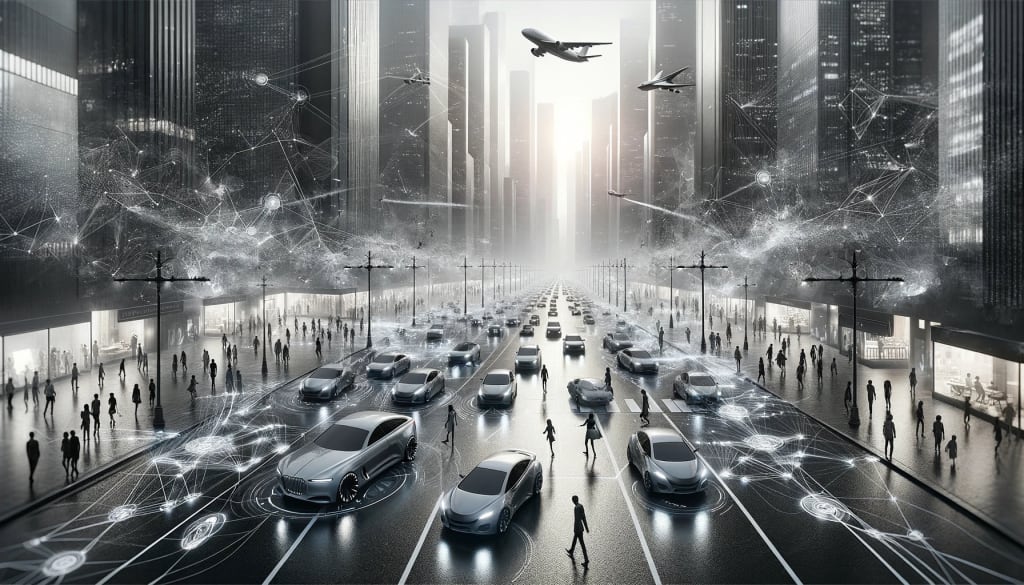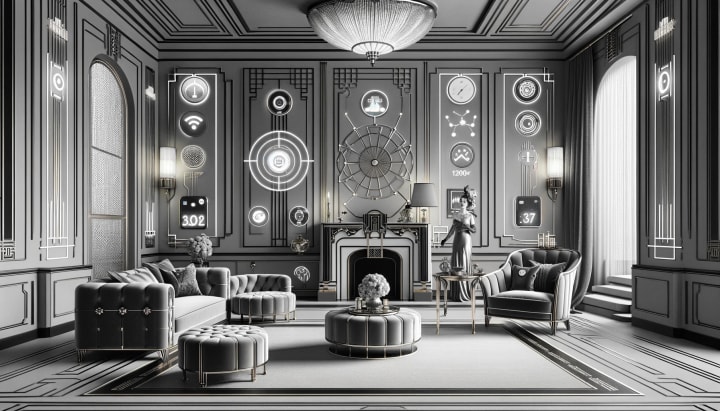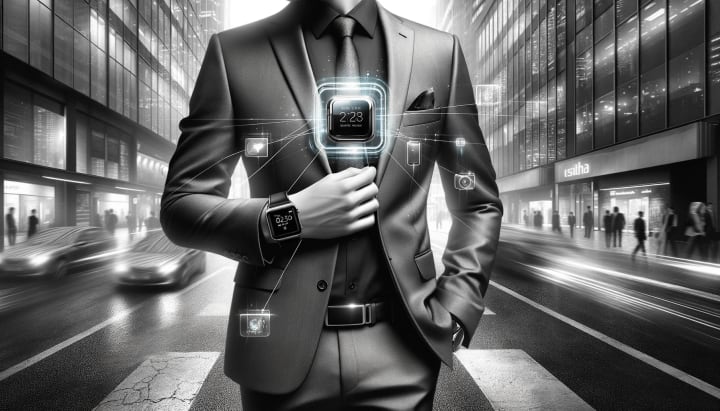Ambient computing and the sublimation of the user interface.
Ambient computing will change everything you know about developing and interacting with technology.

Outside of technology circles and articles, you would be hard-pressed to find mainstream discussion around ambient technology. However, according to some of technology’s luminaries and largest companies, it represents one of the seismic changes in how you interact with computing and organise your daily life. This is a revolution that has been quietly gathering momentum in the background.
Ambient computing is a paradigm that exists at the intersection of several technologies, and technology enablers which include Artificial intelligence, Smart Agents, Internet of Things, Mesh networks, System on a chip and Natural Language Processing. As the enablers of ambient technology have been maturing, now we see the emergence of applications of ambient technology in the consumer device market in powerful ways.
Even personal computing pioneers such as Bill Gates have noted that this paradigm shift is going to completely change the way you use computers. For decades the button-based interfaces that you have used to instruct your computer on what to do, across a myriad of single-purpose applications, will be replaced by a personal assistant that travels across devices, interacts seamlessly and can perform complex actions on your behalf. [1]
Ambient computing could very well be pushing your current suite of computing devices towards a rapid extinction. [2] [3]
What is ambient computing?
Well, that’s a sublime question. Ambient computing is disappearing technology. Technology that becomes so seamless that you take it for granted in your daily life, the interface dissolves into the background and it becomes ‘nothing’. Performing complex tasks will become as simple as talking in natural language about what you want to do.
Before the smartphone, you were tethered to your desktop computer. Before the desktop computer, you were tethered to a fixed phone. Now you are tethered to your smartphone and yet smartphones have become saturated with applications with little context or cross-portability. Now it is time to be untethered from your phone and its applications, into a space where the concept of a ‘user interface’ becomes very different.
In the world of ambient computing, there is a vision of untethering, where you will have a personal assistant that is available wherever you go, and your whole world is a computer. [4]
It sounds a little abstract, a little science fiction, however, it is fast becoming the reality. Imagine a world where staring at screens and clicking on buttons is replaced by people interacting directly with the physical world, pulling up information on demand and performing complex tasks when they need it.
Simply speaking or gesturing to the mirror will tell you about your mood and health today. You can give a command and have your calendar adjusted and bookings made on your behalf. As you walk between rooms your agent follows you. It’s in your mirror, in your stereo speakers, in your digital personal assistant, in your sunglasses.
When you walk into a room all of the room’s digital capabilities will be automatically connected, your profile known and contextualised with the objects in the room, which will respond intuitively to your situation and the instructions that they receive.
The barriers between you and your computing will ‘disappear’ and become ‘nothing’. It will fade into the background of your life. There will be no screen and keyboard, there will be no ‘user interface’. [5] [6]

The Rabbit R1 has sold out both batches of 10,000 units over two days. What is the enthusiasm for the R1? I’ve seen various articles speak to what is driving the interest however no articles have discussed the fundamental change to the user interface or user experience. It is an example of a new paradigm, the Human-AI Experience. Where before you needed to click through various applications in a crowded application-heavy smartphone, now you can simply ask for actions to be performed and Rabbit R1, through its Large Action Model (LAM), will navigate the required applications to complete the task.
In short, then, it is a total game changer for making AI useful. Apart from generating text or images, it can now actually do useful things to automate your world. No more crowded interfaces full of applications and no more frustration flicking between different applications to perform a task.
Now when you extrapolate this trend, even slightly, you can see where a Human-AI experience model can become untethered and be available on a wide range of different devices. The Rabbit R1 is a pioneer in ambient computing.
The leap to untethered computing seems consequential from the development of the technology enablers. It feels inevitable. [7] [8] [9] [10]
If you feel this is far-fetched, I don’t blame you. However, if you have a Google Nest, Amazon Echo, or Apple Watch, or even use anything that is AI-enabled, then you are already on this journey and perhaps just haven’t recognised it yet.
Facilitating the untethered life
To facilitate the untethered life there is a confluence of technologies required to exist in harmony with each other. Some of these technologies are well-advanced and mature, some are yet to reach maturity. The problem with the widespread understanding of ambient technology is that, for the moment, many of the concepts remain very technical, a generally inaccessible acronym soup full of techno-jargon that is impenetrable to most non-technical people. (e.g. IoT, LLM, LAM, HaX, AxD, 5G, SOC, Z-Wave, Zigbee etc.).
Some of the most important enablers can be readily explained in more accessible terms.
- System on a chip — With increasing density and manufacturing techniques such as 3nm and 5nm precision machining, more and more functionality can be packed onto a single chip. The single chip, rather than representing a component in a large system, now represents the complete system. This leads to faster data transfer, lower power consumption and ultimately, miniaturisation of capability onto a smaller device. [11]
- Artificial Intelligence — There has been a lot written about AI and the innovation curve that it is currently experiencing, both from large language models and on-device, edge-based models, but also from the point of view of natural language processing. There is also the move to intelligent agents, which can perform real actions on behalf of a user. With AI accelerating faster than forecasters anticipated and training costs continuing to fall by 75% per year, the fusion of these powerful models with other technology enablers will also accelerate ambient computing. [12]
- Internet of Things (IoT) — Ambient computing is built on top of IoT. IoT refers to the wide range of devices that are connected to the internet. Latest innovations in IoT include local large language models which can be run on small edge devices. [13]
- Mesh networks — One of the underpinning enablers of ambient computing is the ability for you to move from one space to another with your devices also moving seamlessly from space to space. This enables the ability to move seamlessly within the environment with applications, devices and models sharing location and context. Further development is needed in this area however we already have the precursors in the form of 5G, Z-Wave, WiFi and Zigbee.
Re-writing the rulebook for software
The typical innovation process in software development goes through a familiar cycle of ideation, research, prototyping, A/B testing, click-throughs and user focus groups/cohorts. This traditional user experience research places the customer at the forefront of user-centric design. This human-centred approach revolves around the concept of a user interface, a way in which a user can interact with the computer that is intuitive to their requirements
Over the years, user interfaces have improved along with the availability of more computing power and graphical memory. The search for functional richness delivered with simplicity has been the goal, and design tools such as Storybook and Figma have created powerful collaborative tools for designing these user interfaces.
However, user interfaces are deeply flawed as a concept. They remain at their very core, a poor approximation for a human/machine interface that delivers to customer needs. However intuitive they are, you still need to know how to use them, and you still need to orchestrate and instruct them by knowing what to do.
What if all that effort that went into the design of your user interface, is about to be disintermediated by ambient computing? What if a machine could generate a better user interface on demand than you could statically design?
It could be, that your traditional user interface shortly is almost worthless. Existing only to instruct a machine on how to drive your business logic to achieve something. You have been disintermediated by ambient computing.
Changes to the way customers experience technology are going to have profound changes to the way technology is designed and built. When smart devices become pervasive, everyday objects and spaces can now provide a connected experience, everywhere, at all times. User experience becomes more about space and place, than about interface.
The interface disappears into ‘nothing’ and becomes a gesture, or a voice instruction. The instruction is enriched with personal context, profile, geo-spatial location, field of vision, and emotion. [14]

The ai pin from Humane has all of the characteristics of ambient computing with a minimalistic ‘beyond screen’ approach that heavily leans on gestures, touch, voice and artificial intelligence in a wearable device. It is designed to enable natural and effortless computing interactions and weave seamlessly into the lives of customers. The device is a ‘post smartphone’ wearable that has generated considerable hype and comparisons with the Rabbit R1 [16].
There is a similarity between both devices as attempts to address the ‘apps problem’, however, their approach is very different. The ai pin is likely best described as a ‘wearable LLM’, however, the Rabbit R1 takes a step further with advanced actionability. Both devices have puzzled analysts with their intentions and led to scepticism about replacing the smartphone. However, those analysts have not applied the ambient computing lens on the market and therefore are missing the long-sighted view, that the game in user interfaces has changed. [17]
To deal with this new paradigm of ambient computing, new forms of design thinking have emerged.
- Ambient Experience Design (AxD) — The emerging interdisciplinary design practice that fuses traditional UX/UI, industrial design, textiles, architecture and interiors to cater for the customers that inhabit them. [18]
- Human-AI Experience (HaX) — The rise of HaX and also ambient experience design has shifted this conversation from ‘place’ to ‘space’. We are now forced to think of interactions outside the screen, a move from buttons to ambient experiences. The retail industry could be a big beneficiary of this development. [19]
- Ambient Intelligence (Aml) — New forms of interactive applications supporting everyday activities across smart spaces with seamless cross-connectivity and diverse micro-interface forms. The emergence of ‘generative GUI’s’ in real-time depending on context may emerge, forever eliminating the ‘static’ user interface paradigm of the current generation. [20]
The area of ambient computing is wide open for innovation and we’re likely going to see a rush of innovation into this space. Not only is the technology cost dramatically reducing for bringing ambient products to market, but the large players of the technology industry are heavily invested in this trend. [21]
It’s not a surprise then that large technology players are quietly rushing into this paradigm. There is an emerging world where they could become dis-intermediated, and they fail to capitalise on a fast-moving new computing paradigm that is likely to change everything.
References
[1] Gates, Bill., (2023) AI is about to completely change the way you use computers. Gates Notes
[3] Meghmala., (2023) What is Ambient Computing and its Future? Analytics Insight
[5] Lacoma, Tyler., (2021) What is ambient computing, DigitalTrends
[9] Nield, David., (2024) What exactly is the Rabbit R1? CES 2024’s AI breakout hit explained. Techradar
[10] Rashid, Dua., (2024) The Rabbit R1 Seems Cool, But What The Hell Is It? Gizmodo
[11] Elgendy, Mohamed., (2023) Emerging System-on-a-Chip Trends to Watch Out For, AZO Materials
[12] Wood, Cathie., et. al., (2024) Big Ideas 2024. ARK Invest
[13] Narayan, Vishnu., (2022) Ambient Computing: What Is It & How Will It Change Our lives? ThinkPalm
[16] Gulen, Kerem., (2024) Rabbit R1 vs AI Pin: Detailed comparison, Dataconomy
[18] Vasudev, Janani., (2019) Being Present: The Future is Ambient, OpenMic
[21] Alba, Davey., Chang, Emily., (2022) Google Devices Chief Says ‘Ambient Computing’ Is Future Goal
About the Creator
David Jenkins
David is an accomplished technology executive with over 25 years of experience in product and technology, holding senior executive positions in global companies such as Bloomberg, Thomson Reuters and Fidessa.






Comments
There are no comments for this story
Be the first to respond and start the conversation.